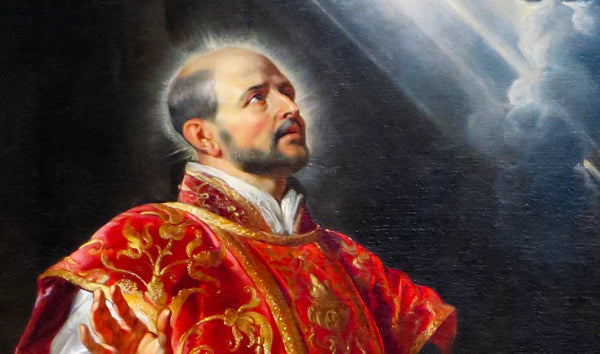
Saint Ignatius of Loyola - From Spanish Knight to God's Warrior
|
|
|
|
Table of contents
Saint Ignatius of Loyola fought as a soldier and then after he took a cannonball to the shin he fought for Christ. He is best known for starting the Society of Jesus (The Jesuits) and the "Ignatian spirituality" that came from it. Many have benefited from his "daily examen" and other spiritual writings.
Ignatius, a member of the Spanish army, was embroiled in a tough battle against the French. His military career would be a short one. A cannonball struck him in the lower right leg and proceeded to tear open his left calf. The French captured him and carried him on a stretcher to the castle of Loyola to recover.
His broken leg was so badly set that the surgeons had to re-break it. After they set it again, Ignatius came down with a severe fever. He nearly died the night before the feast of Saints Peter and Paul. Miraculously his health took a turn for the better. However, it took months for him to fully recover and involved attaching weights to his right leg in an attempt to stretch it out. This didn't prove to be very effective, as Ignatius walked with a limp for the remainder of his life. It was this tedious physical healing that led to his "spiritual recovery."
As he lay in bed, the future Saint Ignatius of Loyola, asked for romance books to fight his boredom. However, all the Castle had to offer was a book about Jesus's life and the lives of the Saints. At first, he read the stories just to kill the time, but later on, he fell in love with them. He spent entire days re-reading the stories about the saints and he asked himself "...why then should I not do what they have done?" He realized the emptiness of worldly glory and was convinced that only God could make his soul content. Ignatius learned that the thoughts of consolation, peace, and tranquility were from God. He resolved at this point to imitate the saints and weep for his sins.
One night, Ignatius saw the Blessed Mother in a pool of light with the Christ child in her arms. This vision filled him with so much joy that he was inspired to go on a pilgrimage to the shrine of Our Lady at Montserrat. The experience inspired him to lead a life of penance. Initially, he was filled with peace, but soon he was attacked by fear and scrupulosity. Prayer, fasting, discipline, and the sacraments couldn't remove the sadness from his soul. He was on the brink of despair, but God was with him. It was at this time that Ignatius began to write what would become his Spiritual Exercises book. Peace returned to his soul, and once again, he was flooded with joy. The saint soon had a knack for curing souls overrun with scrupulosity.
The success of his spiritual exercises gained Ignatius many companions. He met these brothers in faith during his studies in France. Notable among these was Saint Francis Xavier, but all of them were fervent in their faith. Due to his health, Ignatius had to leave Paris and spend more than half a year in Spain before moving on to private study in Italy. His companions eventually joined him. They then spent 18 months in ministry and then on June 24th, 1537, most of them entered the priesthood.
The Society of Jesus, also known as the Jesuit order, saw its creation in the final years of Ignatius's life. In 1539, the companions wanted to make their union permanent. To do this, they resolved to add a vow of obedience to an elected superior in addition to obedience to the pope and the vows of poverty and chastity. Ignatius became their leader in an election. Under his leadership, the Jesuits grew rapidly. The Jesuits numbered 1,000 companions divided into groups of 12.
Later in his life, Ignatius fine-tuned the rules of his religious order. The "Constitutions of the Society of Jesus" got rid of some of the traditional practices common to religious life such as chanting of the divine office and physical punishment. These new constitutions put an emphasis on flexibility so that each member was “ready to live in any part of the world where there was hope of God’s greater glory and the good of souls.”
Ignatius was sick the majority of the time that he was in charge of the Jesuit Order. In 1551, he attempted to resign as his health continued to fail. His members wouldn't accept his resignation, so he remained in charge until his death in 1556. He was beatified in 1609 and later canonized in 1622. Three centuries later, in 1922, Pope Pius XI declared Ignatius of Loyola the patron of spiritual retreats.
The "Daily Examen" came from the holy mind of Ignatius while he was in the process of writing "Spiritual Exercises." The prayer is a simple and honest assessment of how our relationship with God is going at the moment. The believer identifies the moments of consolation and or desolation in his or her day. They ask the question: what's making me closer to or farther away from God?
Dearest Lord,
teach me to be generous;
teach me to serve You as You deserve;
to give and not to count the cost,
to fight and not to heed the wounds,
to toil and not to seek for rest,
to labour and not to ask for reward
save that of knowing I am doing Your Will.
Amen.
Source: Catholic Online

